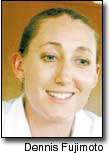A Department of Health program to identify sources of pollution and measure the levels in two Nawiliwili streams completed its public input phase this week, and plans are underway to outline restoration projects for the watershed’s future. The last public
A Department of Health program to identify sources of pollution and measure the levels in two Nawiliwili streams completed its public input phase this week, and plans are underway to outline restoration projects for the watershed’s future.
The last public meeting for the Nawiliwili Watershed Restoration Project was Wednesday, Dec. 17 at noon, at the Lihu’e Neighborhood Center.
The meeting was the third of three stages of developing a watershed restoration plan that started as part of a grant through the Department of Health as a program of the Environmental Protection Agency about two years ago, according to Monika Mira, a representative from the University of Hawai’i Water Resource Research Center.
A watershed is the area that drains to a common waterway, such as a stream, lake, estuary, wetland, or ocean. The first stage of the Nawiliwili Watershed Restoration Project was identifying sources and amounts of pollution. The other parts of the project were water testing and gathering public input.
David Penn, from the Department of Health’s Environmental Planning Office (Environmental Health Division), briefed about a half-dozen officials from the Department of Water, state Department of Transportation, Department of Land and Natural Resources-Division of Aquatic Resources; and state Highways-Kaua’i office; about results of water testing for bacteria and pollution levels and total maximum daily loads in Huleia and Nawiliwili Streams.
According to the EPA, a total maximum daily load, or TMDL, is a calculation of the maximum amount of a pollutant that a body of water can receive and still meet water quality standards.
A TMDL is the sum of the allowable amounts of a single pollutant from all point and non-point sources. The calculation must include a margin of safety to ensure that the water body can be used for the purposes the state has designated. The calculation must also account for seasonal variations. The EPA has listed Nawiliwili’s pollutants as sediment and foreign particles that run into the water.
Mira, who is working on this project as a water technician, commented that all runoff in Lihu’e runs straight into the streams with no kind of filters.
One area where water tests have found high levels of bacteria is the culvert behind the Kauai Marriott Resort & Beach Club, which runs directly into Nawiliwili Stream and to the ocean.
It is important for business owners, people who live in the Lihu’e, Niumalu and Nawiliwili areas and government officials to get informed about what they can do in the future to help restore the water quality, she said.
Mira said last week that she has been meeting with interested parties to discuss possible activities, ranging from highly technical, research-based projects, to service learning and community volunteer undertakings.
Some proposed activities include treating runoff water in catchbasins using filters; constructing wetlands and sediment basins; getting involved with policies and regulations for new developments and building projects; educating the public and business owners; and involving other state, non-profit and community agencies and organizations.
Once written up, the plan will be forwarded to the state Department of Health for review. It is not yet clear when the plan will be implemented, Mira said. However, those who are interested in finding out the results of the testing and data collection are invited to come to the meeting.
Staff Writer Kendyce Manguchei can be reached at kmanguchei@pulitzer.net or 245-3681 (ext. 252).


